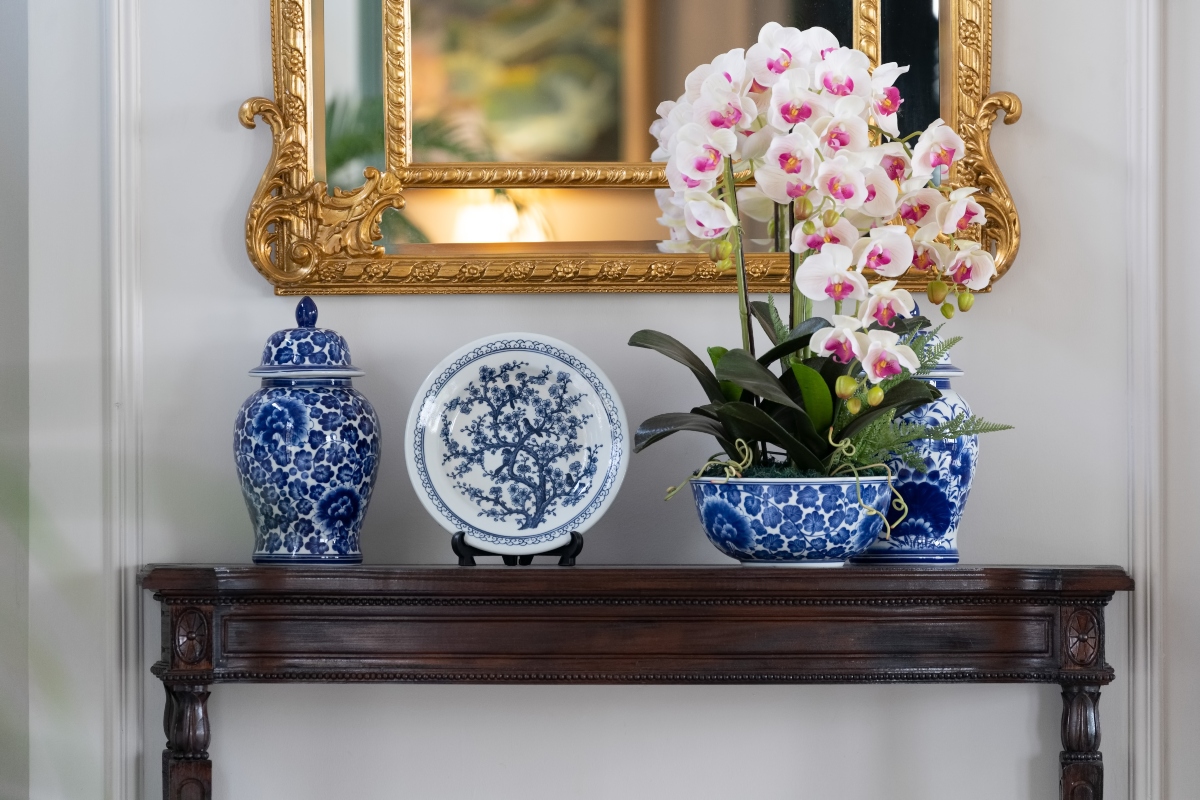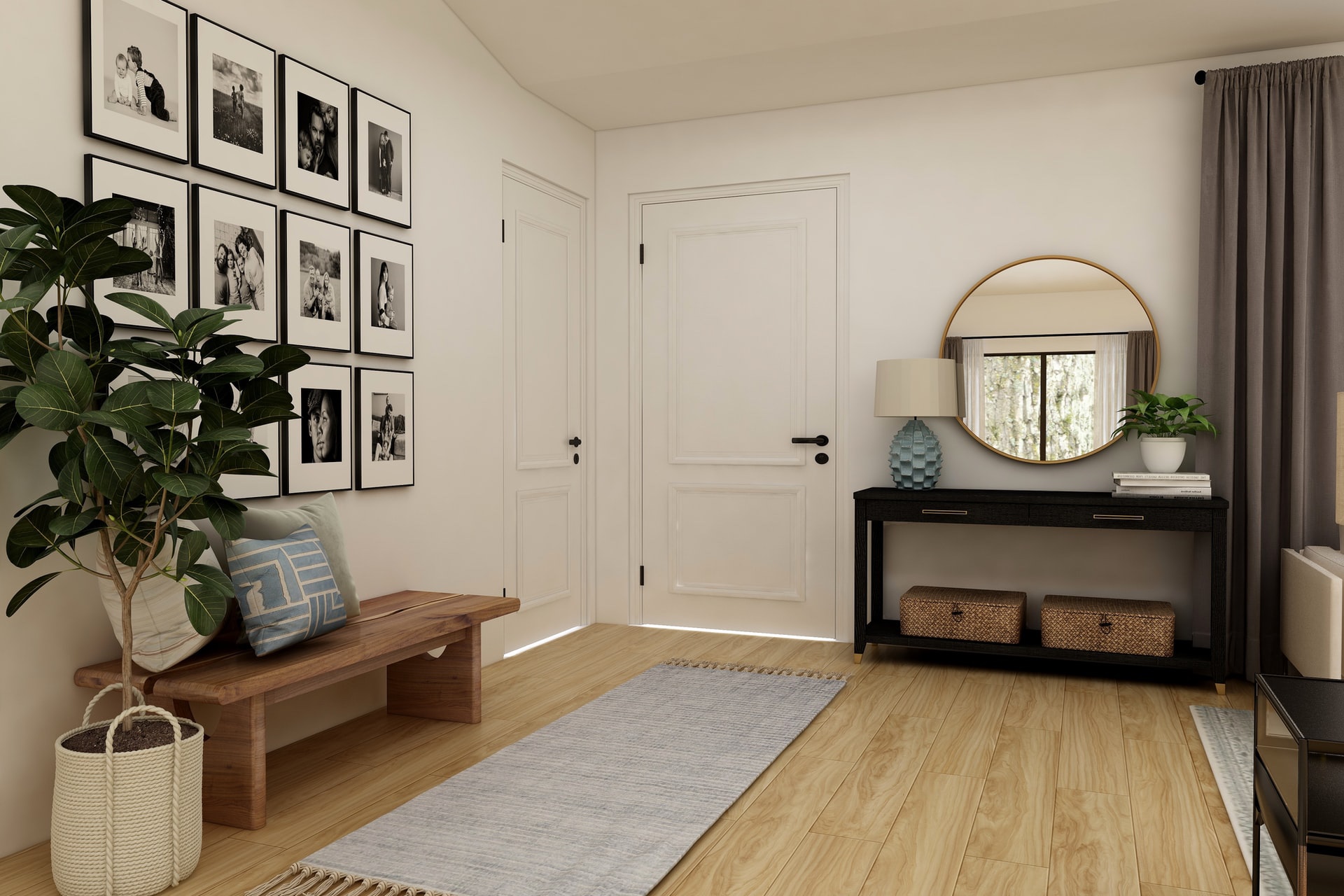The entrance to your home should make you happy when you walk in, and it should welcome guests when they pass through it. No matter how small the entryway, it should be a reflection of your personal style. If you pay attention to foyer organization, you can design an impactful and useful entryway that wows.
1. Make it functional

If you know you are going to walk by a table with a drawer and drop your keys somewhere, put one in with a tray or bowl to hold your keys. Put in a bench, chairs, or just one chair. You can use a narrow and tall table if space is at a premium. Be sure to put something welcoming on the table as well. It could be a vase of flowers you can change out periodically or a sign with an inspirational message.
If there is room under the table, you can also put a horizontal wicker basket with a liner or a pretty crate to put boots and extra shoes. And if you’ve got the room, pick up a vintage dresser at a secondhand or thrift store. It makes a perfect place for the key bowl, but you can also use the drawers for mittens, gloves, hats, scarves, seasonal purses, backpacks, and even extra linens.
2. Think about balance

Light is important because brightness is welcoming. You can balance the light from the windows or skylights by putting an entryway mirror on the opposite wall or using matching lamps, either on the table or as floor lamps. However, consider the scale. If you have a huge entryway, you don’t want one little chair and one tiny table — get a substantial table or a smaller table with two upholstered chairs.
Add a bench if you’ve got the room with some nice comfortable cushions and throw pillows. Put an ottoman with one of the chairs. Even better, make sure the bench has storage underneath, so it does double duty as a place to take off your boots and a place to store items. It’s functional and it increases your closet space.
Anchor the entryway with an area rug. Adding a rug may seem counterproductive because there’s going to be dirt and perhaps snow and water tracked in, but the rug is necessary to define the space. Use a textured rug with flecks of color for texture and to help mask the dirt between cleanings.
Don’t be afraid to show your personality with accessories or wall art with a pop of color. For example, use groupings of photos or groupings of artwork for a more symmetrical look.
3. Adjust for the space

For a small foyer, use lighter colors that move the eye around and spread the light throughout it. Apply entryway wall decor that will create interest. A foyer is also a great space to make a statement with wallpaper. You can get some very luxurious and expensive wallpaper and not spend a lot of money because you will only be doing one or two walls. You can paint the other walls with a color you pull from the wallpaper. If it’s a particularly vibrant wallpaper, use a shade of paint one or two shades lighter. Be sure to use gloss paint because it will reflect more light and make the space seem bigger!
For even more storage, use hooks, hook rails, and racks as entryway organizers. These items don’t take up a ton of space but have pretty large capacities. Floating shelves will also add to storage potential and decorate the space without taking up floor real estate.
Some more ideas to adjust for the space:
- Make the space your own. If you like to travel, put some travel accessories out. If you hobby is gardening, place some gardening accessories out.
- Tall plants will help add an organic feel and make the space feel larger.
- A large, oversized mirror — even a full-length mirror — will make the space feel larger.
- Use a variety of textures to add interest.
- Frame the mirror with peg rail and use it to hang hats and purses.
4. Bring in some nature

Incorporating natural elements such as living plants, wood accents, and water features into a small entryway can transform the space into a serene and welcoming area. Living plants introduce a refreshing burst of greenery, enhancing air quality and creating a calming atmosphere. Wood accents add warmth and a touch of rustic charm, making the space feel cozy and inviting.
Water features, even small ones, provide a soothing sound that can reduce stress and promote relaxation. Together, these elements create a harmonious and balanced environment, making even a small entryway a delightful transition from the outside world.
5. Craft an entryway if needed

Some open-concept homes have no appreciable foyer space. However, it is still possible to create a space to function as an entryway. Get a comfortable chair with a standing lamp next to it. If you can, get a small table — even if it’s just big enough for a pretty little tray to set your keys on.
Remember: Scale, light, and personality. An entryway should have furniture that fits the scale of the space, and you should use as much light as you can. Add wall sconces or floor lamps if needed. People feel welcomed when you share, so put some accessories out that reflect your personality.




